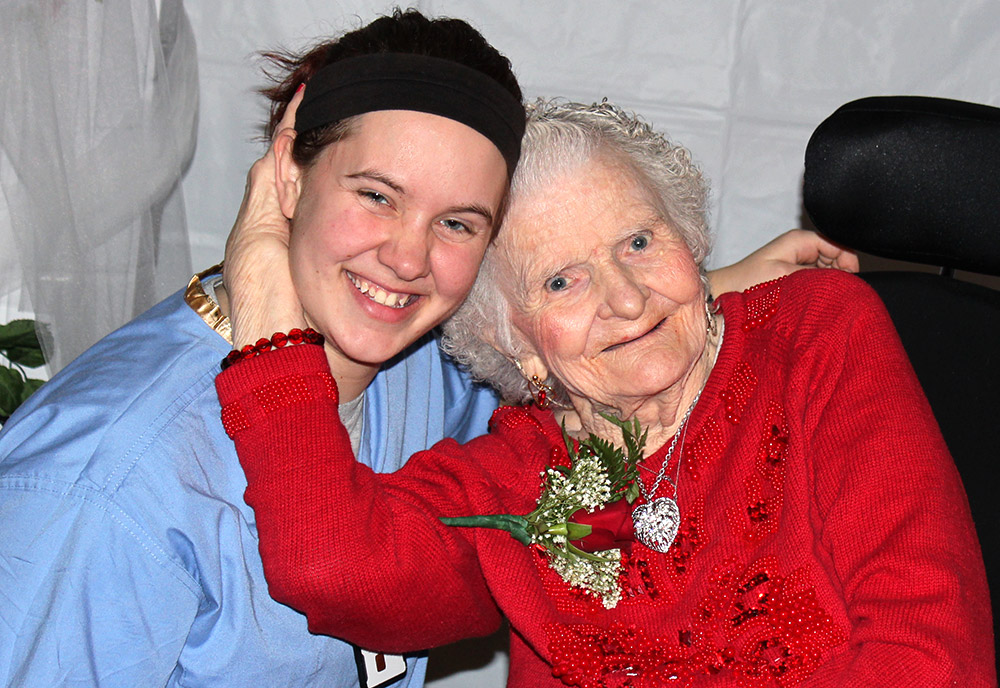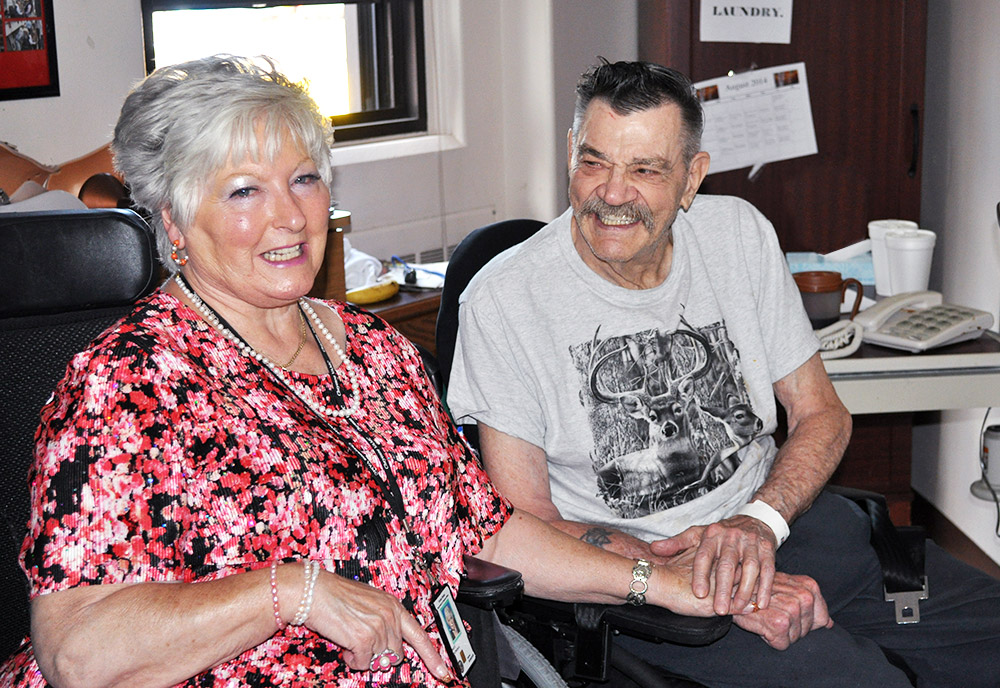Veterans Health Administration
At Wyoming VA, No Veteran Dies Alone

Mary, a resident at the Cheyenne VA community living center, clearly enjoys the company of Brittny Leaman, an energetic young VA nursing assistant.
“The thing I’m most worried about,” actress Anne Hathaway once said, “is just being alone without anybody to care for or someone who will care for me.”
Well, Anne, the nice folks at the Cheyenne VA Medical Center in Wyoming sort of feel the same way you do which is why they launched a program called ‘No Veteran Dies Alone,’ where volunteers from the VA — as well as the local community — spend time with Veterans who are in their final days or hours.
Chief Chaplain Carol Carr, who started the program at the Cheyenne VA in 2012, said she and her team now train about 20 to 25 volunteers each year.
“Fortunately, we never have too many Veterans in hospice at any one time,” she explained, “so most of our work is done at our Old Glory Community Living Center. Our volunteers also visit patients in the Intensive Care Unit, or wherever else they’re needed.”
It’s not always easy work.
Thanks, But No Thanks
“The one Veteran I think about the most is someone who didn’t even want my help,” said Mary Jo Alley, a volunteer who works for Disabled American Veterans. “He and his wife were very private people, and mainly wanted to be left alone. They really didn’t want us to be around. She wanted to be the one taking care of him and he didn’t want anyone taking care of him but her. So we just backed off, but we let them know we’d be there for them if they needed us.”
Eventually, the couple accepted the offer.
“Taking care of a dying spouse can be exhausting,” Alley observed. “Sometimes you need a break; you need someone to fill in for you so you can rest. I think the wife finally got to that point. I remember I went into their room one day; I told her I could sit with her husband while she went and got something to eat. She actually took me up on my offer.
“So she left. And that’s when the husband got really upset. He got angry and told me to leave him alone. So I did. I got up and left. But as I was walking out the door he called me back and he actually apologized for being so cantankerous. I think he finally realized that I was there for him, as well as for his wife. So I sat with him for a while. I didn’t want him to be alone.”
Sometimes, toward the end, they’re not alert anymore. So you just sit with them and hold their hand and hope they are somehow aware that someone is with them.
— Mary Jo Alley, volunteer
Cribbage, Anyone?
Mary Homiak, a program support specialist at the Cheyenne VA, said her heart was touched by one Veteran who never had any visitors.
“He was very lonely,” she said. “He had no family here. I remember playing cribbage with him. He loved to play cribbage. It’s a card game. The first time we played cribbage, he didn’t like the way I was counting my cards. So we played his way. And that made him happy.”
And then there’s Mary.
“I kind of adopted this one lady, Mary, who’s in her 90s,” Homiak explained. “Or maybe she’s adopted me. Every Wednesday I visit her at the community living center and we usually go shopping. Mary’s a shopper. I’ll take her out to the mall. She loves to look at jewelry and she likes to wear jewelry. We also take her to the beauty salon because her appearance is very important to her.”
“Mary likes to have a beer too. When we go out to dinner after a day of shopping, she has to have her beer. So we sit there and have a beer together. She can’t tell its non-alcoholic. It’s that St. Paulie’s beer.”
Homiak said her desire to help Veterans living out their final days may be rooted in a sad experience involving her dad.
“My father was a World War II Vet,” she said. “At the end of his life he had lung cancer. I lived in a different state back then and couldn’t see him all that often. Mom was there with him at the hospital, but I couldn’t be there as much as I wanted to…
“It broke my heart,” she said.
Appreciation and Respect
Navy Veteran Michael McGhghy recently lost his 83-year-old father, a Marine Corps Veteran, who died peacefully in VA hospice in Cheyenne.
“It was good to have someone there, watching over him,” McGhghy said of the volunteers who visited his dad. “It took a big load off us, because we couldn’t be there all the time.
“Towards the end, they weren’t just there for him; they were there for us as well,” he observed. “They were comforting us. They explained that he wasn’t in pain. Even though he couldn’t speak anymore, they told us he could still hear, that we could still talk to him.”
McGhghy said his father died in the company of his family, as well as VA staff and volunteers who respected him and genuinely cared about him.
“Dad lived at the VA community living center for 10 years before entering hospice, so everybody knew him,” the Navy Veteran explained. “They all thought the world of dad. They liked him. They appreciated him while he was alive and they were there for him when he died.”

Volunteer Anne Picot spends some quality time with her friend Tom, a Navy Veteran who resides at the VA community living center in Cheyenne.
Anger and Fear
Anne Picot, 73, is another volunteer with a special place in her heart for Veterans nearing the end of life. She herself has been confined to a wheelchair for 30 years, having been struck with polio as a very young woman living in her native England.
“I remember this one Veteran,” she said in her soft English accent. “As soon as I saw him, I knew he was very, very sick and didn’t have long to live. But he was also very angry. He was quite suspicious of everything and everyone when he arrived here and he wouldn’t make eye contact. He never had visitors; no one came to see him. He was alone. And he was afraid, because he knew he was dying. He was 59 years old.”
“Loneliness, I think, is the worst thing that can happen to you,” she said.
Despite the lack of conversation and eye contact, Picot would sit quietly with the Veteran for hours at a time. Eventually her comforting presence — along with her endless patience — began to have an effect. The angry, dying Veteran began to loosen up.
“He began to trust me,” she said. “He started making eye contact with me and talking to me. I remember he had these big, brown eyes. He would talk to me about his life, about all kinds of things. Little by little, I watched his anger and his fear leave him.
“One night, after I’d been sitting with him for several hours, I told him it was time for me to go home. Before I could leave he grabbed my hand and told me he loved me very much. I told him I loved him, too and that it was a privilege to be his friend. Then I told him that he and I would one day see each other again.”
After that, the Veteran faded quickly.
“When he was really dying, he couldn’t talk anymore and his eyes were closed all the time,” Picot said. “So all I could do was sit with him and hold his hand.
“Toward the very end, I told him I wished he would wake up so I could see those brown eyes one more time. But of course, he didn’t open his eyes.”



















